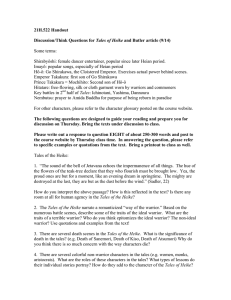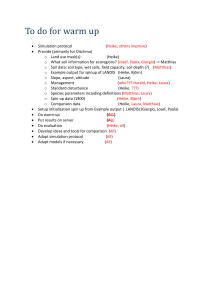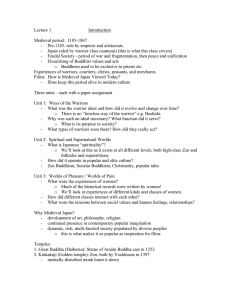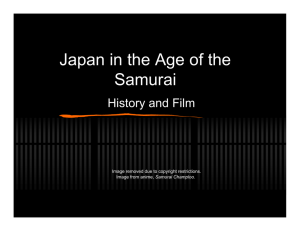Lecture 2 The Emergence of Warrior Society Discussion of Zen:
advertisement
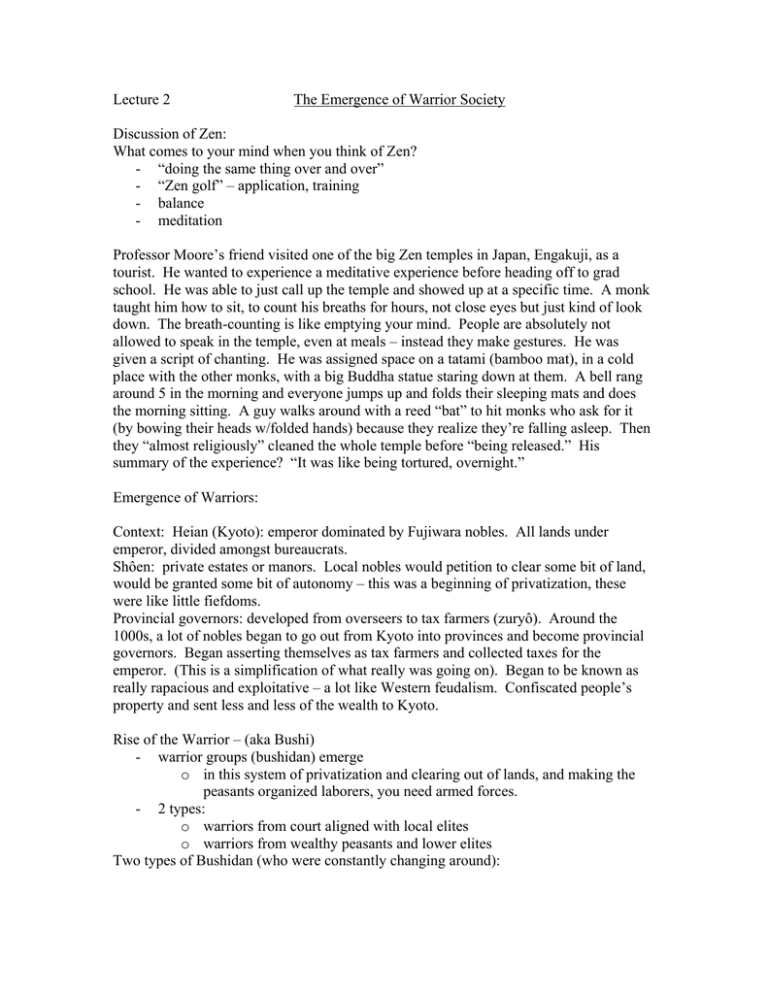
Lecture 2 The Emergence of Warrior Society Discussion of Zen: What comes to your mind when you think of Zen? - “doing the same thing over and over” - “Zen golf” – application, training - balance - meditation Professor Moore’s friend visited one of the big Zen temples in Japan, Engakuji, as a tourist. He wanted to experience a meditative experience before heading off to grad school. He was able to just call up the temple and showed up at a specific time. A monk taught him how to sit, to count his breaths for hours, not close eyes but just kind of look down. The breath-counting is like emptying your mind. People are absolutely not allowed to speak in the temple, even at meals – instead they make gestures. He was given a script of chanting. He was assigned space on a tatami (bamboo mat), in a cold place with the other monks, with a big Buddha statue staring down at them. A bell rang around 5 in the morning and everyone jumps up and folds their sleeping mats and does the morning sitting. A guy walks around with a reed “bat” to hit monks who ask for it (by bowing their heads w/folded hands) because they realize they’re falling asleep. Then they “almost religiously” cleaned the whole temple before “being released.” His summary of the experience? “It was like being tortured, overnight.” Emergence of Warriors: Context: Heian (Kyoto): emperor dominated by Fujiwara nobles. All lands under emperor, divided amongst bureaucrats. Shôen: private estates or manors. Local nobles would petition to clear some bit of land, would be granted some bit of autonomy – this was a beginning of privatization, these were like little fiefdoms. Provincial governors: developed from overseers to tax farmers (zuryô). Around the 1000s, a lot of nobles began to go out from Kyoto into provinces and become provincial governors. Began asserting themselves as tax farmers and collected taxes for the emperor. (This is a simplification of what really was going on). Began to be known as really rapacious and exploitative – a lot like Western feudalism. Confiscated people’s property and sent less and less of the wealth to Kyoto. Rise of the Warrior – (aka Bushi) - warrior groups (bushidan) emerge o in this system of privatization and clearing out of lands, and making the peasants organized laborers, you need armed forces. - 2 types: o warriors from court aligned with local elites o warriors from wealthy peasants and lower elites Two types of Bushidan (who were constantly changing around): A: zuryo and shoen administrators, myoshu: head of a named rice paddy – people on the ground getting money from the peasants. Gradually became pretty rich themselves. Local people/gentry – began to assert their rights against “foreigners” from Kyoto and “uppity” peasants. All of these possessed their own armed groups. B: independent myoshu alliances Taira and Genji bushidan: imperial descendents who went to provinces; they would use the Taira name to invade lands. - Court increasingly surprised by rebelliousness of bushidan. Also around the 1000s – “retired emperors”. Assertion of power against the Fujiwara. . Began to limit the privatization of lands Shirakawa forms “in no cho” (cloister govt) in 1086. Retired emperors begin to form alliances with mid-level nobles, bushidan, and temples Rise of the Taira: “Hôgen Uprising” 1156 – brought warriors into the top of society. There was a succession dispute after Toba’s death. A Fujiwara faction rebelled against Go Shirakawa to put someone else on throne; he uses some of the Genji to put down this uprising. Heiji Uprising 1159: Go used both the Taira (Heike) and Genji, but gave Heike more rewards. They then burned down his palace while he was away. Emergence of Taira no Kiyomori power. Genpei Wars Kiyomori wins - Go Shirakawa tries to revolt against Kiyomori, gets placed under arrest. - 1180: Prince Mochihito issues call to arms - Yoritomo consolidates East from Kamakura: turns officials into his own vassals. Gradually creates his own vast territory. - Inspires a lot of Bushidan uprisings in central Japan, e.g. Kiso Yoshinaka. - Death of Kiyomori: fever, 1181 - Heike attack Kiso and are defeated - Kiso chases Heike out of Kyoto - Heike flee west with child emperor Antoku - Kiso’s bored soldiers loot/terrorize Kyoto - Go Shira. Asks Yoritomo to drive out Kiso, who sends Yoshitsune - Yoshitsune defeats Heike at Ichinotani - Yoshitsune ambushes Heike at Yajima and finally defeats them at Dannoura naval battle - Empress commits suicide with Antoku 1185: - Yoritomo gains power during war - Kills half-brother, Yoshitsune (he was the hero of the wars!) - Authority to appoint shugo and jito 1192: appointed seii tai shogun (this is where the word shogun comes from): “subduer of the barbarians”. Supposed to put down uppity warriors and barbarians, and collect “rent” from people on the land. Performing the Heike: - Popular literature performed all over the country by Biwa hoshi; performed purifying rites, told edifying tales; affiliated with temples, formed guilds and regional brotherhoods. It’s a jumble of Buddhist tales and warrior tales; both aristocratic tales and bits added by wandering religious travelers. Voice was very important – it had magical, evocative power. Belief that tales can bring spirits back, call back the dead; also, these tales could pacify those spirits. Often performed in sacred spaces, or would create a sacred space in which to perform the tales (e.g. putting up an umbrella). - There were different vocal techniques for different types of scenes (battle, spirituality, etc.). - Voice + biwa + space reinforces the dramatic moments of the stories. Watch Kwaidan
